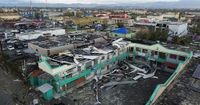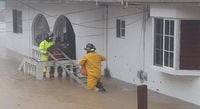On October 28, 2025, the island nation of Jamaica faced the fury of Hurricane Melissa, a Category 5 behemoth that would become the strongest storm in the country’s recorded history. The impact was immediate and devastating, with sustained winds reaching a staggering 185 mph, catastrophic flooding, and storm surges that rendered much of the coastline unrecognizable. As the hurricane’s eye passed over central Jamaica, thousands of residents huddled in shelters, bracing for the worst as the most intense wind and rain battered their communities.
According to the Associated Press, public infrastructure across Jamaica—including hospitals and shelters—was inundated with floodwaters, while power outages and downed communication lines left hundreds of thousands in the dark and cut off from loved ones. The destruction was not limited to Jamaica: neighboring Haiti and Cuba also suffered, with Haiti reporting at least 25 deaths by October 29 as rivers burst their banks and homes collapsed under relentless rain.
In the days that followed, the scale of the disaster became painfully clear. By October 30, more than 77% of Jamaica remained without power, and over 25,000 people crowded into emergency shelters. Black River, the capital of St. Elizabeth Parish on Jamaica’s southwestern coast, was described by Mayor Richard Solomon as “totally destroyed.” Prime Minister Andrew Holness told the Associated Press, “Black River is what you would describe as ground zero. The people are still coming to grips with the destruction.”
Residents across the island shared harrowing stories of survival. Natassia Wright recounted to CNN, “It was terrifying. Hearing the wind howling outside, hearing the sea roaring, wondering what’s going to happen next, seeing trees fall—these trees have been around for ages—seeing different objects flying around in the wind. It was scary.” In White Hall, a devastated community, Sheryl told Convoy of Hope, “It’s going to be very hard to get back up.”
As the storm’s immediate threat subsided, the focus shifted to recovery. Convoy of Hope, an international humanitarian organization, was among the first to respond, distributing food, clean water, and essential supplies to families in White Hall, Black River, and other hard-hit areas. “Every bottle of clean water and every box filled with food is more than supplies; it carries the message that amid the devastation there is hope, and that help is here,” Convoy of Hope reported in their updates. The organization’s commitment extended beyond Jamaica, with relief efforts underway in Haiti and other affected Caribbean nations.
International support quickly mobilized. The United Nations, recognizing the enormity of the disaster, allocated $4 million from the Central Emergency Response Fund (CERF) to rapidly scale up humanitarian operations in Jamaica. According to a statement from UN Emergency Relief Coordinator Tom Fletcher, “In times like this, international solidarity isn’t just a principle—it’s a lifeline.” Around 13 UN agencies, including UNICEF, the World Food Programme (WFP), and the Pan-American Health Organization (PAHO), worked alongside Jamaican authorities to clear roads, repair infrastructure, and deliver emergency health, water, and sanitation services. UNICEF reported that more than 700,000 children across the Caribbean were impacted by Hurricane Melissa, with over 284,000 children in Jamaica receiving urgent nutrition, safe water access, sanitation, hygiene, and mental health support.
UNICEF and the UN Office for the Coordination of Humanitarian Affairs (OCHA) also coordinated supply deliveries to Cuba and Haiti, where similar devastation was unfolding. In Cuba, a $4 million CERF allocation allowed agencies to pre-position food for 180,000 people, deploy mobile water-treatment units and hygiene kits, and airlift medical supplies and generators. The Cuban Red Cross, in coordination with the International Federation of Red Cross (IFRC), assisted with preventive evacuations, early-warning messages, and psychosocial support.
General aviation played a vital role in the response. The National Business Aviation Association (NBAA) activated its Humanitarian Emergency Response Operator (HERO) Database to mobilize disaster-response efforts from the business aviation community. Organizations such as Operation Air Drop, AERObridge, Airlink, and Samaritan’s Purse coordinated airlifts of relief supplies. Samaritan’s Purse, for example, flew 38,000 pounds of supplies—including shelter tarps, solar lights, medical supplies, and water filtration systems—into Kingston’s Norman Manley International Airport, which remained the only Jamaican airport open to limited commercial and general aviation operations as of the evening of October 30.
Nari Williams-Singh, director general of the Jamaica Civil Aviation Authority, described the situation at Montego Bay-Sangster International Airport as dire: “We have all hands on deck to get up and running as quickly as possible.” Efforts were also underway to reopen Ian Fleming International Airport in Ocho Rios, as access to the island remained a critical challenge for relief operations.
Despite the outpouring of aid, the road to recovery is daunting. Five days after the hurricane’s landfall, many residents were still waiting for assistance, with entire communities cut off by impassable roads and lacking power and running water. The Jamaican government reported that the death toll had risen to at least 28 by November 2, as the full extent of the tragedy became known. “The entire Jamaica is really broken because of what has happened,” Jamaican Minister of Education Dana Morris Dixon told the Associated Press. Yet, amid the heartbreak, the resolve to rebuild was palpable. “Our country has been ravaged by Hurricane Melissa, but we will rebuild, and we will do so even better than before,” Prime Minister Holness affirmed in a Facebook post.
Recovery efforts have been bolstered by the international community’s commitment. António Guterres, Secretary-General of the United Nations, spoke by phone with Prime Minister Holness, underscoring that “international support is crucial” as Jamaica copes with the hurricane’s aftermath. Relief chief Tom Fletcher echoed this sentiment, calling for “the mobilisation of massive resources to deal with the loss and damage from the hurricane.”
In Haiti, where humanitarian needs were already acute due to ongoing crises, early warning systems and pre-positioned aid helped save lives. Over 3.5 million alerts were sent to vulnerable populations, and UN agencies supported temporary shelters, food distribution, and cash assistance for those displaced by the storm. “Local leadership, global solidarity, and early action are saving lives across the region,” Fletcher noted. “This is the humanitarian reset at work—acting together with greater impact.”
As Jamaica and its Caribbean neighbors begin the long journey of recovery, stories of resilience and hope emerge alongside the destruction. Aid organizations, government agencies, and communities are working hand in hand to restore normalcy, rebuild infrastructure, and care for the most vulnerable. The scars left by Hurricane Melissa will not soon fade, but the collective response—local and international—offers a path forward, one marked by solidarity, compassion, and determination.






